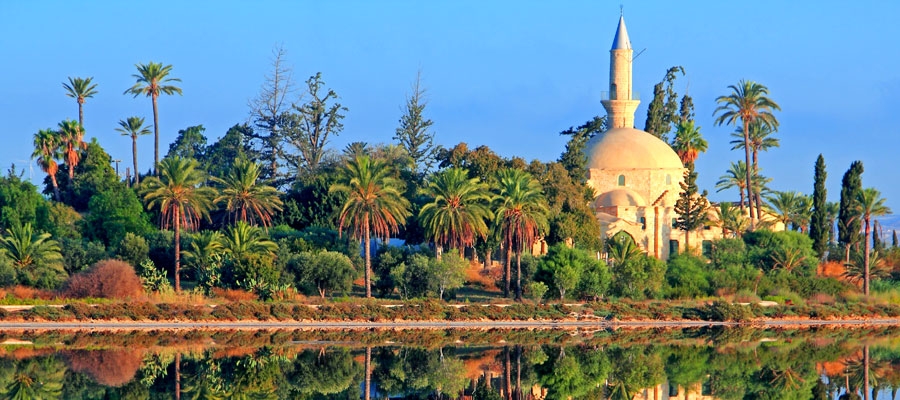Having as a starting point the 9th century church of Agios Lazaros, one of the most remarkable examples of Byzantine architecture and where the sarcophagus (Larnax) of Saint Lazarus lies, we head south-east towards Dromolaxia (Artemidos Avenue leading to B4 road) to the Hala Sultan Tekke. According to the legend, Um Haram, who was related the Prophet Mohammed, died when she fell off her mule, during one of the first Arab raids on the island and was buried on the very spot where the mosque was built.
Not far away, in the same direction, is the village of Kiti and its main point of interest the church of Panagia Angeloktisti. According to local tradition, while building the church an army of angels was coming down at night to help build it; hence the name ‘Angeloktisti’ (‘built by Angels’). On the conch of the apse lays the famous mosaic of Panagia tis Aggeloktistis of the 6th c. A.D. This mosaic is considered to be one of the most significant and elaborate wall mosaics of Early Christian art, depicting the Virgin standing, holding baby Jesus in her left arm, with the Archangelos Michael and Gabriel on either side.
In a short distance to the west of Kiti (just of the B4 road) lies the Turkish Cypriot village of Kivisili. At the center of the village is the church of Panagia Eleousa, dedicated to the Virgin Mary.
Next stop in our visit is the church of St. Catherine in Klavdia, which was converted into a mosque during Ottoman Empire in Cyprus. Our route takes us to the ruined cloister of “Panagia Stazousa”. Today, only the church remains intact with its characteristic gothic ornaments and fragments of frescoes in the interior.
Further to the north towards Pyrga village, we will visit the Royal Chapel. Considered to be one of the most interesting surviving structures from the Frankish Period on the island, the Royal Chapel was built in 1421 by the Lusignan King Janus and its mural decoration includes a series of coats-of-arms of the Medieval Kingdom of Cyprus.
The route ends at the monastery of Stavrovouni which is perched on a synonymous rocky peak. Legend has it that it was founded in the 4th century by St. Helena, mother of Emperor Constantine the Great, who left a relic of the Holy Cross at the monastery.
Monuments: Church of Agios Lazaros in Larnaka (Larnaca), Hala Sultan Tekke at Dromolaxia, Church of Panagia Angeloktisti in Kiti, Church of Panagia in Kisivili, Church / Mosque of Agia Aikaterini in Klavdia, Gothic Church of Panagia Stazousa and Royal Chapel in Pyrga and Monastery of Stavrovouni.
Total route length: 70 km.

